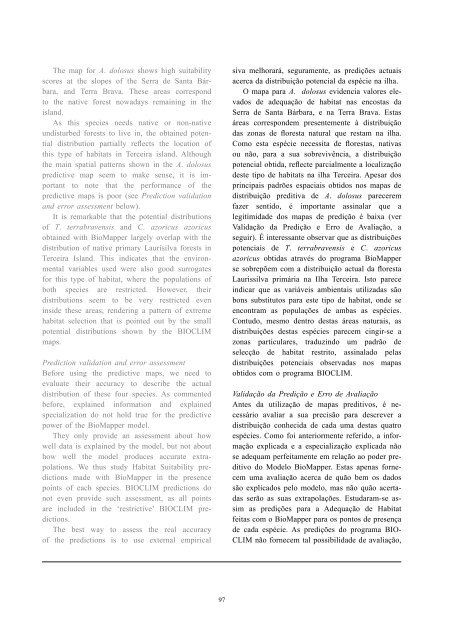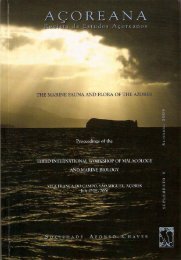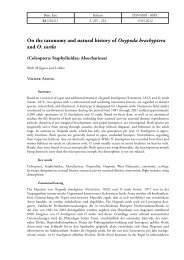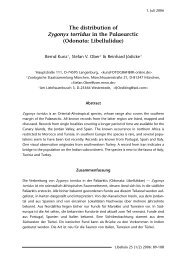(eds.) (2005). - Portal da Biodiversidade dos Açores - Universidade ...
(eds.) (2005). - Portal da Biodiversidade dos Açores - Universidade ...
(eds.) (2005). - Portal da Biodiversidade dos Açores - Universidade ...
Create successful ePaper yourself
Turn your PDF publications into a flip-book with our unique Google optimized e-Paper software.
The map for A. dolosus shows high suitability<br />
scores at the slopes of the Serra de Santa Bárbara,<br />
and Terra Brava. These areas correspond<br />
to the native forest nowa<strong>da</strong>ys remaining in the<br />
island.<br />
As this species ne<strong>eds</strong> native or non-native<br />
undisturbed forests to live in, the obtained potential<br />
distribution partially reflects the location of<br />
this type of habitats in Terceira island. Although<br />
the main spatial patterns shown in the A. dolosus<br />
predictive map seem to make sense, it is important<br />
to note that the performance of the<br />
predictive maps is poor (see Prediction vali<strong>da</strong>tion<br />
and error assessment below).<br />
It is remarkable that the potential distributions<br />
of T. terrabravensis and C. azoricus azoricus<br />
obtained with BioMapper largely overlap with the<br />
distribution of native primary Laurisilva forests in<br />
Terceira Island. This indicates that the environmental<br />
variables used were also good surrogates<br />
for this type of habitat, where the populations of<br />
both species are restricted. However, their<br />
distributions seem to be very restricted even<br />
inside these areas, rendering a pattern of extreme<br />
habitat selection that is pointed out by the small<br />
potential distributions shown by the BIOCLIM<br />
maps.<br />
Prediction vali<strong>da</strong>tion and error assessment<br />
Before using the predictive maps, we need to<br />
evaluate their accuracy to describe the actual<br />
distribution of these four species. As commented<br />
before, explained information and explained<br />
specialization do not hold true for the predictive<br />
power of the BioMapper model.<br />
They only provide an assessment about how<br />
well <strong>da</strong>ta is explained by the model, but not about<br />
how well the model produces accurate extrapolations.<br />
We thus study Habitat Suitability predictions<br />
made with BioMapper in the presence<br />
points of each species. BIOCLIM predictions do<br />
not even provide such assessment, as all points<br />
are included in the ‘restrictive’ BIOCLIM predictions.<br />
The best way to assess the real accuracy<br />
of the predictions is to use external empirical<br />
97<br />
siva melhorará, seguramente, as predições actuais<br />
acerca <strong>da</strong> distribuição potencial <strong>da</strong> espécie na ilha.<br />
O mapa para A. dolosus evidencia valores eleva<strong>dos</strong><br />
de adequação de habitat nas encostas <strong>da</strong><br />
Serra de Santa Bárbara, e na Terra Brava. Estas<br />
áreas correspondem presentemente à distribuição<br />
<strong>da</strong>s zonas de floresta natural que restam na ilha.<br />
Como esta espécie necessita de florestas, nativas<br />
ou não, para a sua sobrevivência, a distribuição<br />
potencial obti<strong>da</strong>, reflecte parcialmente a localização<br />
deste tipo de habitats na ilha Terceira. Apesar <strong>dos</strong><br />
principais padrões espaciais obti<strong>dos</strong> nos mapas de<br />
distribuição preditiva de A. dolosus parecerem<br />
fazer sentido, é importante assinalar que a<br />
legitimi<strong>da</strong>de <strong>dos</strong> mapas de predição é baixa (ver<br />
Vali<strong>da</strong>ção <strong>da</strong> Predição e Erro de Avaliação, a<br />
seguir). É interessante observar que as distribuições<br />
potenciais de T. terrabravensis e C. azoricus<br />
azoricus obti<strong>da</strong>s através do programa BioMapper<br />
se sobrepõem com a distribuição actual <strong>da</strong> floresta<br />
Laurissilva primária na Ilha Terceira. Isto parece<br />
indicar que as variáveis ambientais utiliza<strong>da</strong>s são<br />
bons substitutos para este tipo de habitat, onde se<br />
encontram as populações de ambas as espécies.<br />
Contudo, mesmo dentro destas áreas naturais, as<br />
distribuições destas espécies parecem cingir-se a<br />
zonas particulares, traduzindo um padrão de<br />
selecção de habitat restrito, assinalado pelas<br />
distribuições potenciais observa<strong>da</strong>s nos mapas<br />
obti<strong>dos</strong> com o programa BIOCLIM.<br />
Vali<strong>da</strong>ção <strong>da</strong> Predição e Erro de Avaliação<br />
Antes <strong>da</strong> utilização de mapas preditivos, é necessário<br />
avaliar a sua precisão para descrever a<br />
distribuição conheci<strong>da</strong> de ca<strong>da</strong> uma destas quatro<br />
espécies. Como foi anteriormente referido, a informação<br />
explica<strong>da</strong> e a especialização explica<strong>da</strong> não<br />
se adequam perfeitamente em relação ao poder preditivo<br />
do Modelo BioMapper. Estas apenas fornecem<br />
uma avaliação acerca de quão bem os <strong>da</strong><strong>dos</strong><br />
são explica<strong>dos</strong> pelo modelo, mas não quão acerta<strong>da</strong>s<br />
serão as suas extrapolações. Estu<strong>da</strong>ram-se assim<br />
as predições para a Adequação de Habitat<br />
feitas com o BioMapper para os pontos de presença<br />
de ca<strong>da</strong> espécie. As predições do programa BIO-<br />
CLIM não fornecem tal possibili<strong>da</strong>de de avaliação,

















